Implications of GNSS-Inferred Tropopause Altitude Associated with Terrestrial Gamma-ray Flashes
Abstract
1. Introduction
2. Data and Methodology
3. Analyses and Results
3.1. TGF-Related Tropopause Altitude
3.2. Thermal Structure of TGF-Producing Thunderstorms
4. Discussions and Conclusions
- The TGF-associated tropopause altitudes exhibit a similar geographical distribution over the global scale and seasonal characteristics to the climatology. The regionally averaged tropopause altitude over the Caribbean Sea is 0.1–0.4 km lower than the climatology, and that over the African continent is slightly (≤0.1 km) lower than the climatology. The regional tropopause altitudes over the Asian Monsoon are 0.1–0.2 km higher than the climatology. Most of the tropopause altitudes associated with the TGFs are slightly higher than the climatology, while some of them have a slightly negative bias.
- There is no significant land-ocean difference in the thermal structures for the tropical TGF-producing thunderstorms. In the subtropics, the tropospheric temperature was warmed over land, with a 0.5–0.6 km higher −20 °C-level and 0.8 km higher −40 °C-level. Meanwhile, the continental TGF-producing thunderstorms have a colder and higher tropopause than the ocean.
- During the boreal summer season, the TGF-associated tropopause altitudes in the Asian Monsoon region are considerably higher (by about 1.4 km on average) than the Caribbean area, while whether this will lead to a higher incidence rate of TGFs relative to lightning still depends on the altitude of major charge regions of parent thunderstorms.
- The TGF-producing thunderstorms are characterized by a cold anomaly in the middle (around 7–9 km) and upper troposphere (around 15 km) and tend to have stronger anomalies than deep convection found in previous studies.
Author Contributions
Funding
Data Availability Statement
Conflicts of Interest
References
- Fishman, G.J.; Bhat, P.N.; Mallozzi, R.; Horack, J.M.; Koshut, T.; Kouveliotou, C.; Pendleton, G.N.; Meegan, C.A.; Wilson, R.B.; Paciesas, W.S.; et al. Discovery of Intense Gamma-Ray Flashes of Atmospheric Origin. Science 1994, 264, 1313–1316. [Google Scholar] [CrossRef] [PubMed]
- Smith, D.M.; Lopez, L.I.; Lin, R.P.; Barrington-Leigh, C.P. Terrestrial Gamma-Ray Flashes Observed up to 20 MeV. Science 2005, 307, 1085–1088. [Google Scholar] [CrossRef] [PubMed]
- Marisaldi, M.; Fuschino, F.; Tavani, M.; Dietrich, S.; Price, C.; Galli, M.; Pittori, C.; Verrecchia, F.; Mereghetti, S.; Cattaneo, P.W.; et al. Properties of terrestrial gamma ray flashes detected by AGILE MCAL below 30 MeV. J. Geophys. Res. Space Phys. 2014, 119, 1337–1355. [Google Scholar] [CrossRef]
- Briggs, M.S.; Fishman, G.J.; Connaughton, V.; Bhat, P.N.; Paciesas, W.S.; Preece, R.D.; Wilson-Hodge, C.; Chaplin, V.L.; Kippen, R.M.; Von Kienlin, A.; et al. First results on terrestrial gamma ray flashes from the Fermi Gamma-ray Burst Monitor. J. Geophys. Res. Space Phys. 2010, 115, 07323. [Google Scholar] [CrossRef]
- Briggs, M.S.; Xiong, S.; Connaughton, V.; Tierney, D.; Fitzpatrick, G.; Foley, S.; Grove, J.E.; Chekhtman, A.; Gibby, M.; Fishman, G.J.; et al. Terrestrial gamma-ray flashes in the Fermi era: Improved observations and analysis methods. J. Geophys. Res. Space Phys. 2013, 118, 3805–3830. [Google Scholar] [CrossRef]
- Dwyer, J.R.; Schaal, M.M.; Cramer, E.S.; Arabshahi, S.; Liu, N.; Rassoul, H.K.; Hill, J.D.; Jordan, D.M.; Uman, M.A. Observation of a gamma-ray flash at ground level in association with a cloud-to-ground lightning return stroke. J. Geophys. Res. Space Phys. 2012, 117, 10303. [Google Scholar] [CrossRef]
- Hare, B.M.; Uman, M.A.; Dwyer, J.R.; Jordan, D.M.; Biggerstaff, M.I.; Caicedo, J.A.; Carvalho, F.L.; Wilkes, R.A.; Kotovsky, D.A.; Gamerota, W.R.; et al. Ground-level observation of a terrestrial gamma ray flash initiated by a triggered lightning. J. Geophys. Res. Atmos. 2016, 121, 6511–6533. [Google Scholar] [CrossRef]
- Lu, G.; Blakeslee, R.J.; Li, J.; Smith, D.M.; Shao, X.-M.; McCaul, E.W.; Buechler, D.E.; Christian, H.J.; Hall, J.M.; Cummer, S.A. Lightning mapping observation of a terrestrial gamma-ray flash. Geophys. Res. Lett. 2010, 37, 11806. [Google Scholar] [CrossRef]
- Shao, X.-M.; Hamlin, T.; Smith, D.M. A closer examination of terrestrial gamma-ray flash-related lightning processes. J. Geophys. Res. Space Phys. 2010, 115, A00E30.1–A00E30.8. [Google Scholar] [CrossRef]
- Østgaard, N.; Gjesteland, T.; Carlson, B.E.; Collier, A.B.; Christian, H.J.; Cummer, S.A.; Lu, G. Simultaneous ob-servations of optical lightning and terrestrial gamma ray flash from space. Geophys. Res. Lett. 2013, 40, 2423–2426. [Google Scholar] [CrossRef]
- Lyu, F.; Cummer, S.A.; Krehbiel, P.R.; Rison, W.; Briggs, M.S.; Cramer, E.; Roberts, O.; Stanbro, M. Very High Fre-quency Radio Emissions Associated with the Production of Terrestrial Gamma-ray Flashes. Geophys. Res. Lett. 2018, 45, 2097–2105. [Google Scholar] [CrossRef]
- Lyu, F.; Cummer, S.A. Energetic Radio Emissions and Possible Terrestrial Gamma-Ray Flashes Associated With Downward Propagating Negative Leaders. Geophys. Res. Lett. 2018, 45, 10–764. [Google Scholar] [CrossRef]
- Pu, Y.; Cummer, S.A.; Huang, A.; Briggs, M.; Mailyan, B.; Lesage, S. A Satellite-Detected Terrestrial Gamma Ray Flash Produced by a Cloud-to-Ground Lightning Leader. Geophys. Res. Lett. 2020, 47, e2020GL089427. [Google Scholar] [CrossRef]
- Belz, J.W.; Krehbiel, P.R.; Remington, J.; Stanley, M.A.; Abbasi, R.U.; Levon, R.; Rison, W.; Rodeheffer, D.; Abu-Zayyad, T.; Allen, M.; et al. Observations of the Origin of Downward Terrestrial Gamma-Ray Flashes. J. Geophys. Res. Atmos. 2020, 125, 2019JD031940. [Google Scholar] [CrossRef]
- Splitt, M.E.; Lazarus, S.M.; Barnes, D.; Dwyer, J.R.; Rassoul, H.K.; Smith, D.M.; Hazelton, B.; Grefenstette, B. Thunderstorm characteristics associated with RHESSI identified terrestrial gamma ray flashes. J. Geophys. Res. Space Phys. 2010, 115. [Google Scholar] [CrossRef]
- Tiberia, A.; Mascitelli, A.; D’Adderio, L.; Federico, S.; Marisaldi, M.; Porcù, F.; Realini, E.; Gatti, A.; Ursi, A.; Fuschino, F.; et al. Time Evolution of Storms Producing Terrestrial Gamma-Ray Flashes Using ERA5 Reanalysis Data, GPS, Lightning and Geostationary Satellite Observations. Remote. Sens. 2021, 13, 784. [Google Scholar] [CrossRef]
- Barnes, D.E.; Splitt, M.E.; Dwyer, J.R.; Lazarus, S.; Smith, D.M.; Rassoul, H.K. A study of thunderstorm microphysical properties and lightning flash counts associated with terrestrial gamma-ray flashes. J. Geophys. Res. Atmos. 2015, 120, 3453–3464. [Google Scholar] [CrossRef]
- Chronis, T.; Briggs, M.S.; Priftis, G.; Connaughton, V.; Brundell, J.; Holzworth, R.; Heckman, S.; McBreen, S.; Fitzpatrick, G.; Stanbro, M. Characteristics of Thunderstorms That Produce Terrestrial Gamma Ray Flashes. Bull. Am. Meteorol. Soc. 2016, 97, 639–653. [Google Scholar] [CrossRef]
- Beirle, S.; Koshak, W.J.; Blakeslee, R.J.; Wagner, T. Global patterns of lightning properties derived by OTD and LIS. Nat. Hazards Earth Syst. Sci. 2014, 14, 2715–2726. [Google Scholar] [CrossRef]
- Fabró, F.; Montanyà, J.; Velde, O.A.; Pineda, N.; Williams, E.R. On the TGF/Lightning Ratio Asymmetry. J. Geophys. Res. Atmos. 2019, 124, 6518–6531. [Google Scholar] [CrossRef]
- Fu, R. Global warming-accelerated drying in the tropics. Proc. Natl. Acad. Sci. USA 2015, 112, 3593–3594. [Google Scholar] [CrossRef] [PubMed]
- Smith, D.M.; Hazelton, B.J.; Grefenstette, B.W.; Dwyer, J.R.; Holzworth, R.H.; Lay, E.H. Terrestrial gamma ray flashes correlated to storm phase and tropopause height. J. Geophys. Res. Space Phys. 2010, 115, A00E49.1–A00E49.10. [Google Scholar] [CrossRef]
- Zhang, H.; Lu, G.; Lyu, F.; Ahmad, M.R.; Qie, X.; Cummer, S.A.; Xiong, S.; Briggs, M.S. First Measurements of Low-Frequency Sferics Associated with Terrestrial Gamma-Ray Flashes Produced by Equatorial Thunderstorms. Geophys. Res. Lett. 2020, 47, e2020GL089005. [Google Scholar] [CrossRef]
- Son, S.-W.; Tandon, N.F.; Polvani, L.M. The fine-scale structure of the global tropopause derived from COSMIC GPS radio occultation measurements. J. Geophys. Res. Space Phys. 2011, 116, 20113. [Google Scholar] [CrossRef]
- Xian, T.; Homeyer, C.R. Global tropopause altitudes in radiosondes and reanalyses. Atmospheric Chem. Phys. Discuss. 2019, 19, 5661–5678. [Google Scholar] [CrossRef]
- Anthes, R.A.; Bernhardt, P.A.; Chen, Y.; Cucurull, L.; Dymond, K.F.; Ector, D.; Healy, S.B.; Ho, S.-P.; Hunt, D.C.; Kuo, Y.; et al. The COSMIC/FORMOSAT-3 Mission: Early Results. Bull. Am. Meteorol. Soc. 2008, 89, 313–334. [Google Scholar] [CrossRef]
- Paulik, L.C.; Birner, T. Quantifying the deep convective temperature signal within the tropical tropopause layer (TTL). Atmospheric Chem. Phys. Discuss. 2012, 12, 12183–12195. [Google Scholar] [CrossRef]
- Xian, T.; Fu, Y. Characteristics of tropopause-penetrating convection determined by TRMM and COSMIC GPS radio occultation measurements. J. Geophys. Res. Atmos. 2015, 120, 7006–7024. [Google Scholar] [CrossRef]
- Zhang, S.-N.; The Insight-HXMT Team; Li, T.; Lu, F.; Song, L.; Xu, Y.; Liu, C.; Chen, Y.; Cao, X.; Bu, Q.; et al. Overview to the Hard X-ray Modulation Telescope (Insight-HXMT) Satellite. Sci. China Ser. G Phys. Mech. Astron. 2020, 63, 1–18. [Google Scholar] [CrossRef]
- Hajj, G.A.; Ao, C.O.; Iijima, B.A.; Kuang, D.; Kursinski, E.R.; Mannucci, A.J.; Meehan, T.K.; Romans, L.J.; Juarez, M.D.L.T.; Yunck, T.P. CHAMP and SAC-C atmospheric occultation results and intercomparisons. J. Geophys. Res. Space Phys. 2004, 109, 06109. [Google Scholar] [CrossRef]
- Wickert, J.; Beyerle, G.; Konig, R.; Heise, S.; Grunwaldt, L.; Michalak, G.; Reigber, C.; Schmidt, T. GPS radio occultation with CHAMP and GRACE: A first look at a new and promising satellite configuration for global atmospheric sounding. Ann. Geophys. 2005, 23, 653–658. [Google Scholar] [CrossRef]
- Wickert, J.; Schmidt, T.; Michalak, G.; Heise, S.; Arras, C.; Beyerle, G.; Falck, C.; König, R.; Pingel, D.; Rothacher, M. GPS Radio Occultation with CHAMP, GRACE-A, SAC-C, TerraSAR-X, and FORMOSAT-3/COSMIC: Brief Review of Results from GFZ. In New Horizons in Occultation Research; Springer Science and Business Media LLC: Berlin/Heidelberg, Germany, 2009; pp. 3–15. [Google Scholar]
- von Engeln, A.; Andres, Y.; Butenko, L.; Klaes, D.; Marquardt, C.; O’Clerigh, E.; Sancho, F. GRAS radio occultation measurements onboard MetOp. In Proceedings of the 4th FORMOSAT-3/COSMIC Data Users Workshop, Darmstadt, Germany, 8–12 September 2008. [Google Scholar]
- Bonnedal, M.; Christensen, J.; Carlström, A.; Berg, A. Metop-GRAS in-orbit instrument performance. GPS Solut. 2010, 14, 109. [Google Scholar] [CrossRef]
- Bonnedal, M.; Lindgren, T.; Carlström, A.; Christensen, J. MetOp GRAS: Signal tracking performance results. In Proceedings of the 2010 5th ESA Workshop on Satellite Navigation Technologies and European Workshop on GNSS Signals and Signal Processing (NAVITEC), Noordwijk, The Netherlands, 8–10 December 2010; pp. 1–4. [Google Scholar]
- Cohen, M.B.; Inan, U.S.; Said, R.K.; Gjestland, T. Geolocation of terrestrial gamma-ray flash source lightning. Geophys. Res. Lett. 2010, 37, 02801. [Google Scholar] [CrossRef]
- Connaughton, V.; Briggs, M.S.; Holzworth, R.H.; Hutchins, M.L.; Fishman, G.J.; Wilson-Hodge, C.A.; Chaplin, V.L.; Bhat, P.N.; Greiner, J.; Von Kienlin, A.; et al. Associations between Fermi Gamma-ray Burst Monitor terrestrial gamma ray flashes and sferics from the World Wide Lightning Location Network. J. Geophys. Res. Space Phys. 2010, 115, 126–131. [Google Scholar] [CrossRef]
- Mailyan, B.G.; Nag, A.; Dwyer, J.R.; Said, R.K.; Briggs, M.S.; Roberts, O.J.; Stanbro, M.; Rassoul, H.K. Gamma-Ray and Radio-Frequency Radiation from Thunderstorms Observed from Space and Ground. Sci. Rep. 2020, 10, 1–9. [Google Scholar] [CrossRef]
- World Meteorological Organization. Meteorology-a three-dimensional science: Second session of the commission for aerology. World Meteorol. Organ. Bull. 1957, 4, 134–138. [Google Scholar]
- Randel, W.J.; Seidel, D.J.; Pan, L.L. Observational Characteristics of Double Tropopauses. J. Geophys. Res. Atmos. 2007, 112. [Google Scholar] [CrossRef]
- Janowiak, J.; Joyce, B.; Xie, P. NCEP/CPC L3 Half Hourly 4 km Global (60 S–60 N) Merged IR V1; Goddard Earth Sciences Data and Information Services Central (GES DISC): Greenbelt, MD, USA, 2017; Volume 10, p. P4HZB9N27EKU. [Google Scholar]
- Dwyer, J.R.; Smith, D.M. A comparison between Monte Carlo simulations of runaway breakdown and terrestrial gamma-ray flash observations. Geophys. Res. Lett. 2005, 32, 22804. [Google Scholar] [CrossRef]
- Nisi, R.S.; Østgaard, N.; Gjesteland, T.; Collier, A.B. An altitude and distance correction to the source fluence distribution of TGFs. J. Geophys. Res. Space Phys. 2014, 119, 8698–8704. [Google Scholar] [CrossRef] [PubMed]
- Peevey, T.R.; Gille, J.C.; Randall, C.E.; Kunz, A. Investigation of double tropopause spatial and temporal global variability utilizing High Resolution Dynamics Limb Sounder temperature observations. J. Geophys. Res. Space Phys. 2012, 117, 01105. [Google Scholar] [CrossRef]
- Guo, F.; Lu, G.; Wu, X.; Wang, H.; Liu, Z.; Bao, M.; Li, Y. Occurrence conditions of positive cloud-to-ground flashes in severe thunderstorms. Sci. China Earth Sci. 2016, 59, 1401–1413. [Google Scholar] [CrossRef]
- Homeyer, C.R.; Pan, L.L.; Dorsi, S.W.; Avallone, L.M.; Weinheimer, A.J.; O’Brien, A.S.; DiGangi, J.P.; Zondlo, M.A.; Ryerson, T.B.; Diskin, G.S.; et al. Convective transport of water vapor into the lower stratosphere observed during double-tropopause events. J. Geophys. Res. Atmos. 2014, 119, 10–941. [Google Scholar] [CrossRef]
- Biondi, R.; Randel, W.J.; Ho, S.-P.; Neubert, T.; Syndergaard, S. Thermal structure of intense convective clouds derived from GPS radio occultations. Atmospheric Chem. Phys. 2012, 12, 5309–5318. [Google Scholar] [CrossRef]
- Hoskins, B.J.; Rodwell, M.J. A Model of the Asian Summer Monsoon. Part I: The Global Scale. J. Atmospheric Sci. 1995, 52, 1329–1340. [Google Scholar] [CrossRef]
- Highwood, E.J.; Hoskins, B.J. The tropical tropopause. Q. J. Royal Meteorol. Soc. 1998, 124, 1579–1604. [Google Scholar] [CrossRef]
- Cummer, S.A.; Lu, G.; Briggs, M.S.; Connaughton, V.; Xiong, S.; Fishman, G.J.; Dwyer, J.R. The lightning-TGF relationship on microsecond timescales. Geophys. Res. Lett. 2011, 38, 14810. [Google Scholar] [CrossRef][Green Version]
- Lu, G.; Zhang, H.; Cummer, S.A.; Wang, Y.; Lyu, F.; Briggs, M.; Xiong, S.; Chen, A. A comparative study on the lightning sferics associated with terrestrial gamma-ray flashes observed in Americas and Asia. J. Atmos. Solar-Terr. Phys. 2019, 183, 67–75. [Google Scholar] [CrossRef]
- Zhang, H.; Lu, G.; Lyu, F.; Xiong, S.; Ahmad, M.R.; Yi, Q. On the Terrestrial Gamma-ray Flashes preceding narrow bipolar events. Geophys. Res. Lett. 2021, 48, e2020GL092160. [Google Scholar] [CrossRef]
- Lyu, F.; Yang, J.; Zhu, B.; Li, D.; Xiong, S.; Liu, F.; Zhang, H. Terrestrial gamma-ray flashes as the high-energy effect of tropospheric thunderstorms in near-Earth space (in Chinese). Sci. Sin-Phys. Mech. Astron. 2020, 50, 129506. [Google Scholar] [CrossRef]
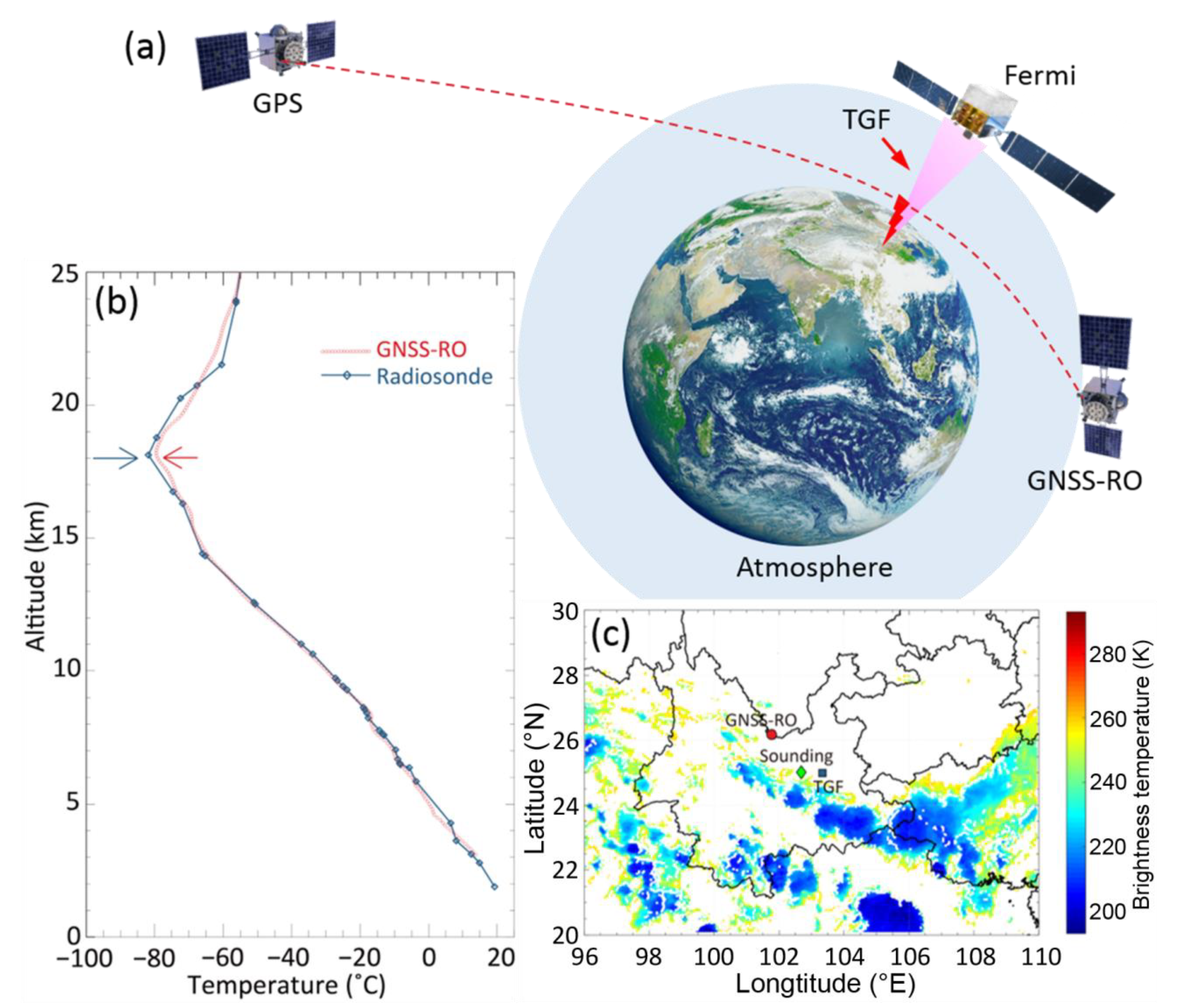
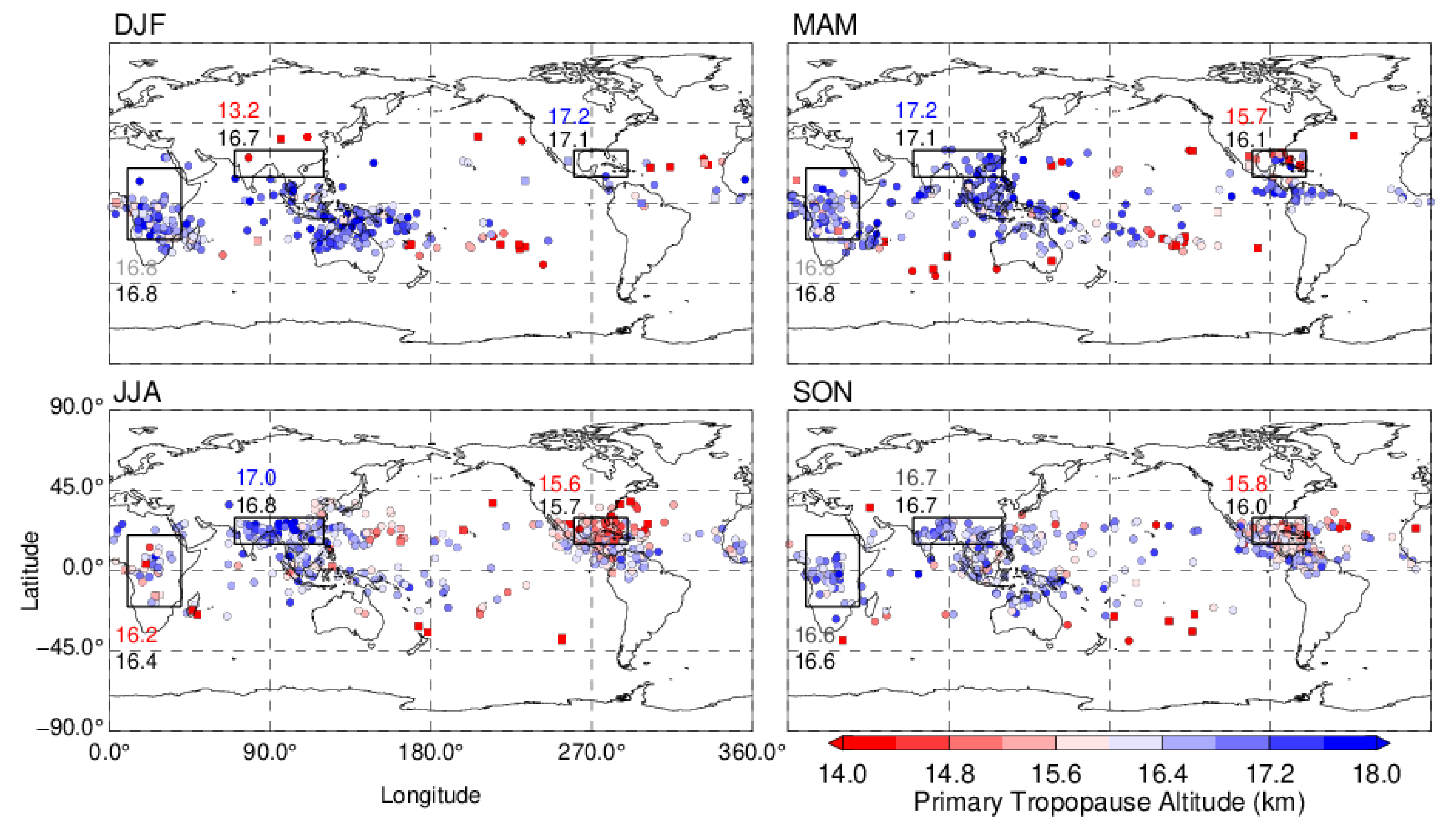
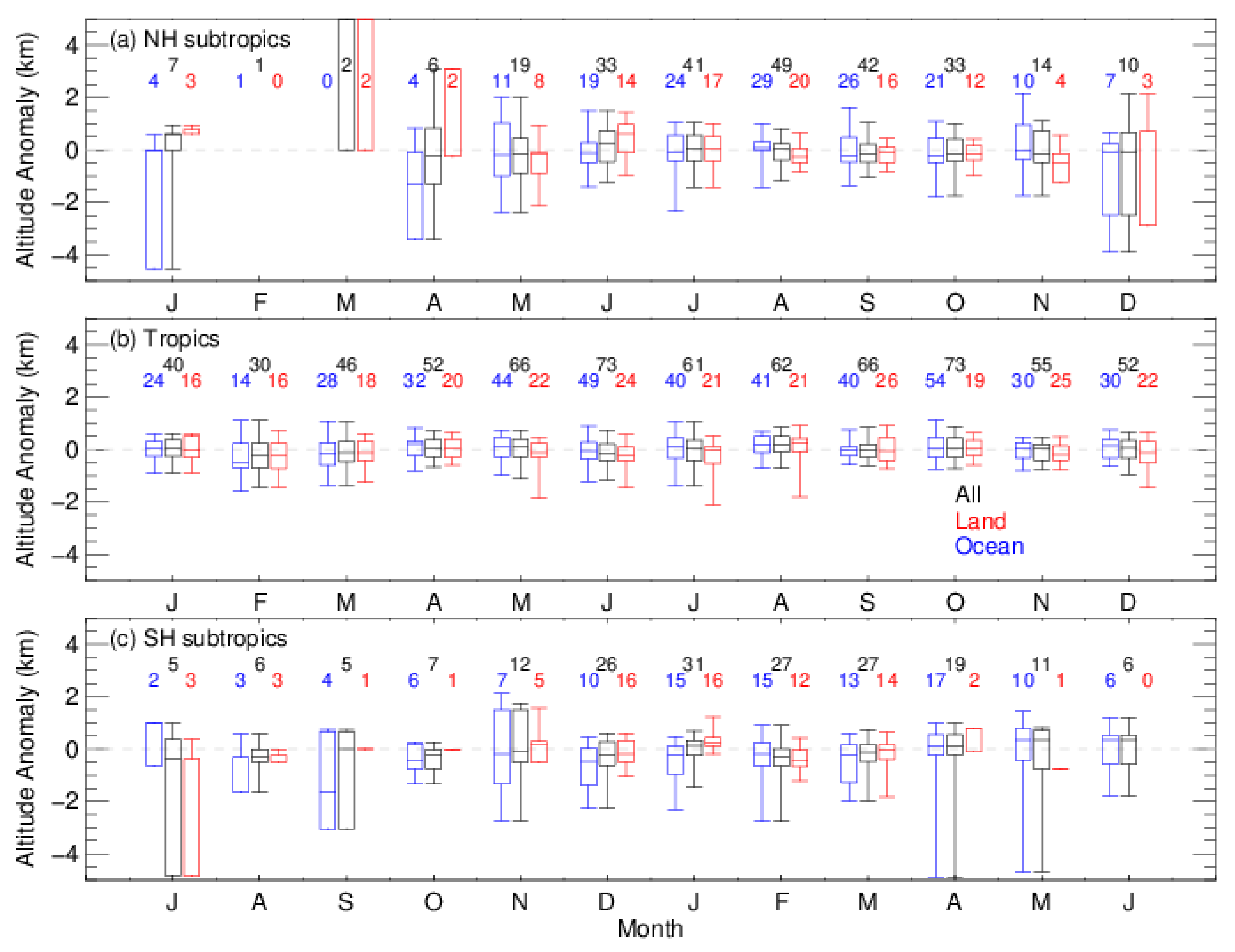
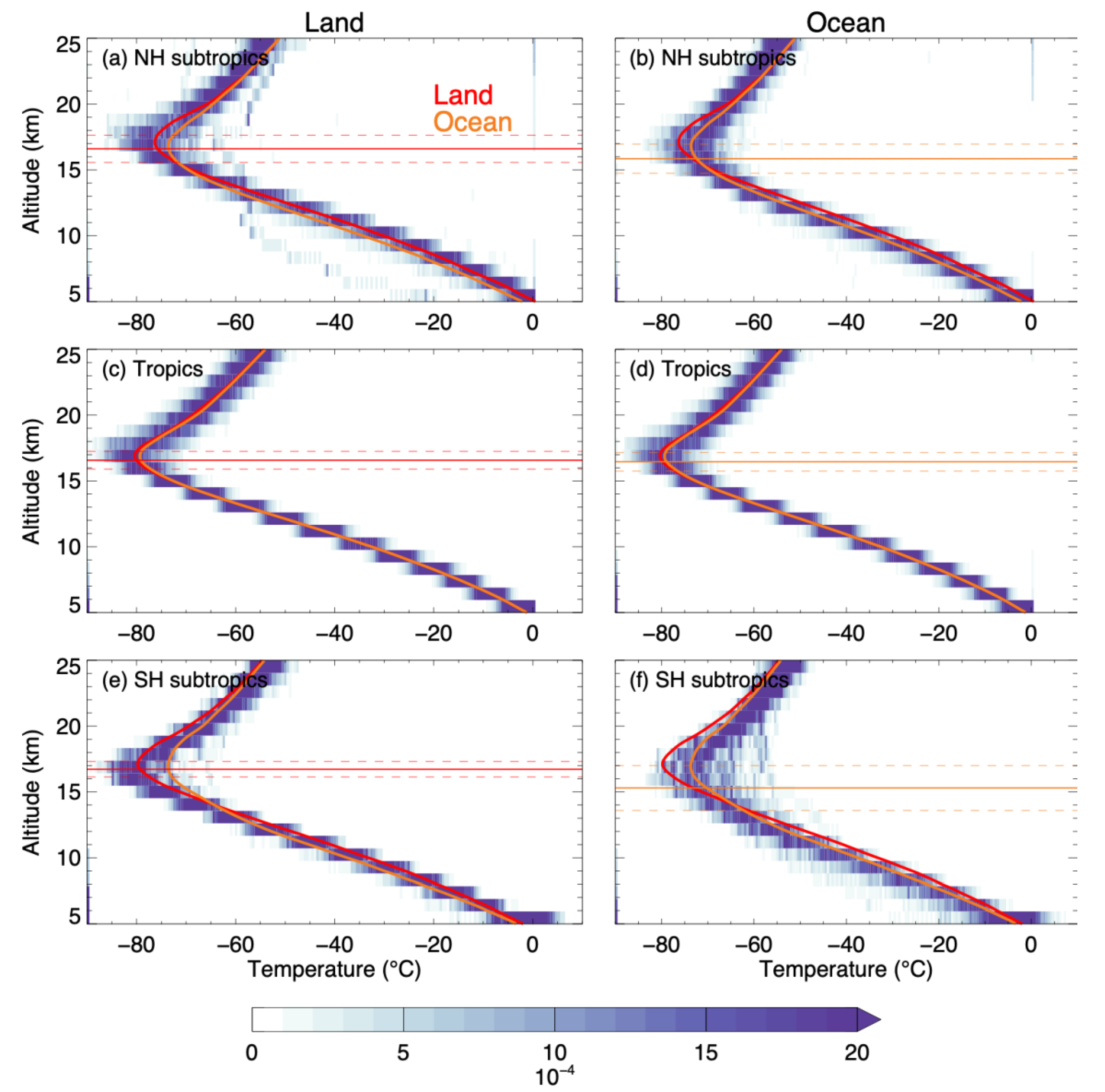
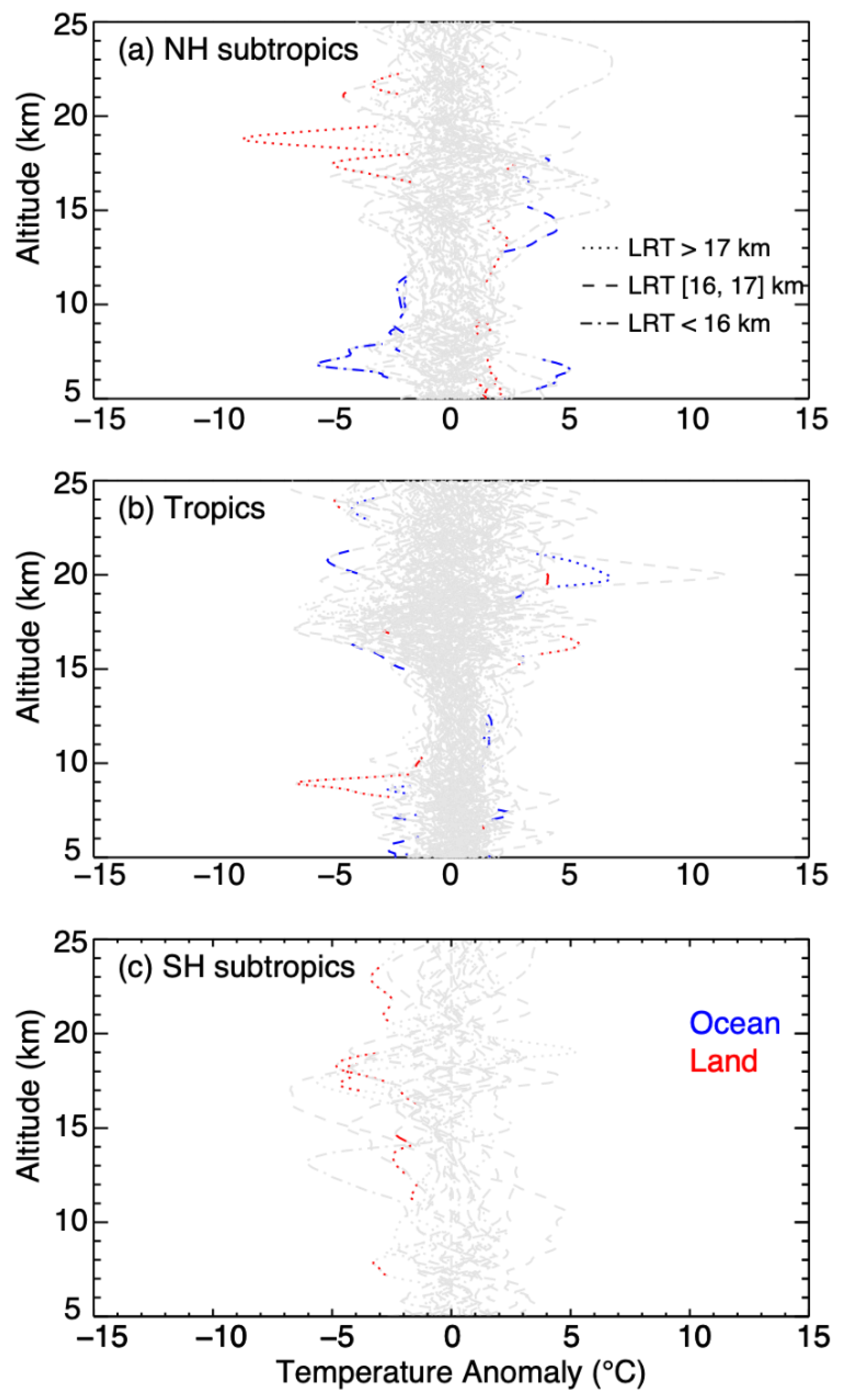
Publisher’s Note: MDPI stays neutral with regard to jurisdictional claims in published maps and institutional affiliations. |
© 2021 by the authors. Licensee MDPI, Basel, Switzerland. This article is an open access article distributed under the terms and conditions of the Creative Commons Attribution (CC BY) license (https://creativecommons.org/licenses/by/4.0/).
Share and Cite
Xian, T.; Lu, G.; Zhang, H.; Wang, Y.; Xiong, S.; Yi, Q.; Yang, J.; Lyu, F. Implications of GNSS-Inferred Tropopause Altitude Associated with Terrestrial Gamma-ray Flashes. Remote Sens. 2021, 13, 1939. https://doi.org/10.3390/rs13101939
Xian T, Lu G, Zhang H, Wang Y, Xiong S, Yi Q, Yang J, Lyu F. Implications of GNSS-Inferred Tropopause Altitude Associated with Terrestrial Gamma-ray Flashes. Remote Sensing. 2021; 13(10):1939. https://doi.org/10.3390/rs13101939
Chicago/Turabian StyleXian, Tao, Gaopeng Lu, Hongbo Zhang, Yongping Wang, Shaolin Xiong, Qibin Yi, Jing Yang, and Fanchao Lyu. 2021. "Implications of GNSS-Inferred Tropopause Altitude Associated with Terrestrial Gamma-ray Flashes" Remote Sensing 13, no. 10: 1939. https://doi.org/10.3390/rs13101939
APA StyleXian, T., Lu, G., Zhang, H., Wang, Y., Xiong, S., Yi, Q., Yang, J., & Lyu, F. (2021). Implications of GNSS-Inferred Tropopause Altitude Associated with Terrestrial Gamma-ray Flashes. Remote Sensing, 13(10), 1939. https://doi.org/10.3390/rs13101939





